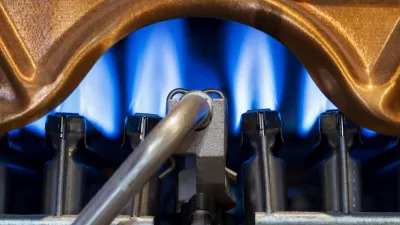Responding to the New York train crash that killed six this month, Sam Tanenhaus reflects on how commuting got so dangerous and why we don't demand better.
The February 3 collision between a Metro-North commuter train and an SUV in suburban New York was the deadliest incident in that rail line's history. An article by Sam Tanenhaus for The New Yorker links that morbid scene with the daily brushes with death that have always come with a hard commute.
There is a sense of disillusionment with the mid-century infrastructural ambitions of Robert Moses, whose aged creations still make up the backbone of suburban New York City. City problems have come to the country, and safety is a concern: "Today those roads—the actual ones—are still charming. But they are also treacherous: the twisty access lanes, the narrow shoulders, the cryptic and poorly placed signage."
Tanenhaus speculates on America’s fixation with the open road and getting out into the country. That story begins with trains, which predate the auto era in a long history of risky transit. He characterizes dangerous commutes as a public health problem, one we accept as inevitable without questioning that might be.
FULL STORY: The Failed Dream of the Easy Commute

Study: Maui’s Plan to Convert Vacation Rentals to Long-Term Housing Could Cause Nearly $1 Billion Economic Loss
The plan would reduce visitor accommodation by 25,% resulting in 1,900 jobs lost.

Alabama: Trump Terminates Settlements for Black Communities Harmed By Raw Sewage
Trump deemed the landmark civil rights agreement “illegal DEI and environmental justice policy.”

Why Should We Subsidize Public Transportation?
Many public transit agencies face financial stress due to rising costs, declining fare revenue, and declining subsidies. Transit advocates must provide a strong business case for increasing public transit funding.

Paris Bike Boom Leads to Steep Drop in Air Pollution
The French city’s air quality has improved dramatically in the past 20 years, coinciding with a growth in cycling.

Why Housing Costs More to Build in California Than in Texas
Hard costs like labor and materials combined with ‘soft’ costs such as permitting make building in the San Francisco Bay Area almost three times as costly as in Texas cities.

San Diego County Sees a Rise in Urban Coyotes
San Diego County experiences a rise in urban coyotes, as sightings become prevalent throughout its urban neighbourhoods and surrounding areas.
Urban Design for Planners 1: Software Tools
This six-course series explores essential urban design concepts using open source software and equips planners with the tools they need to participate fully in the urban design process.
Planning for Universal Design
Learn the tools for implementing Universal Design in planning regulations.
Smith Gee Studio
Alamo Area Metropolitan Planning Organization
City of Santa Clarita
Institute for Housing and Urban Development Studies (IHS)
City of Grandview
Harvard GSD Executive Education
Toledo-Lucas County Plan Commissions
Salt Lake City
NYU Wagner Graduate School of Public Service





























